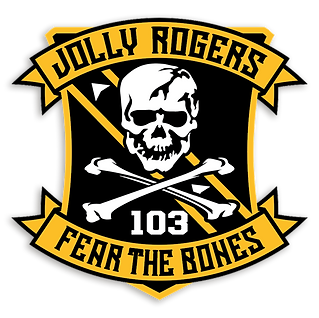
VFA-103 Jolly Rogers
Over the past 63 years, the Skull and Crossbones insignia has flown on nine different types of fighter aircraft, earning its place as one of the most iconic and feared emblems in aviation history. The legacy began in January 1943, when the original Jolly Rogers—VF-17—took to the skies in F4U Corsairs. As the Navy’s most lethal fighter squadron during World War II, VF-17 amassed an impressive 154.5 enemy kills in the Pacific Theater.
In 1946, VF-17 was redesignated as VF-5B, and later as VF-61 in 1948, transitioning from the F4U Corsair to the F8F Bearcat. As the Jolly Rogers moved into the jet age, they flew the Navy's first jet fighters, including the F9F Panther, FJ-3 Fury, and F3H Demon, until the squadron was decommissioned in March 1959.
To preserve the proud tradition of the Jolly Rogers, the VF-84 "Vegabonds," then flying F-8 Crusaders, were redesignated as the Jolly Rogers in June 1959. VF-84 later transitioned to the F-4 Phantom and, in 1975, to the legendary F-14A Tomcat.
When VF-84 was decommissioned in October 1995, the VF-103 "Sluggers" adopted the Jolly Rogers name, insignia, and the tactical callsign "Victory." Commissioned in 1952, VF-103 had already built a distinguished record, including flying missions in Vietnam and scoring the war’s only night MiG kill. With this transition, the Skull and Crossbones found its fifth home, continuing a lineage that spans four fighter squadrons and generations of naval aviation excellence.
VF-103’s final cruise with the F-14B Tomcat came in 2004 aboard USS John F. Kennedy in support of Operation IRAQI FREEDOM. In February 2005, the squadron transitioned to the F/A-18F Super Hornet and was redesignated as VFA-103.
In October 2006, VFA-103 deployed aboard USS Dwight D. Eisenhower (CVN 69) to the CENTCOM area of responsibility, supporting Operations ENDURING FREEDOM, IRAQI FREEDOM, and Horn of Africa missions. After returning in May 2007, the squadron continued a demanding operational tempo. In 2008, the Jolly Rogers transited the Straits of Magellan aboard USS George Washington (CVN 73) during the Partnership of the Americas deployment, followed by another deployment in early 2009 supporting coalition ground forces in Afghanistan.
By January 2010, less than six months later, the Jolly Rogers returned to sea aboard USS Dwight D. Eisenhower for a seven-month deployment. During this period, VFA-103 led Carrier Air Wing SEVEN (CVW-7) in combat operations, flying over 1,850 sorties and nearly 5,900 hours. Their efforts included the delivery of 14 precision weapons, 600 rounds of 20mm ammunition, and over 80 non-kinetic presence missions, directly supporting coalition forces on the ground.
Most recently, the Jolly Rogers completed a historic deployment aboard USS Harry S. Truman (CVN 75) in support of Operation INHERENT RESOLVE. VFA-103 once again demonstrated its lethal effectiveness, delivering 490 precision-guided munitions—more than any other squadron in U.S. Navy history during a single deployment.
Today, VFA-103 remains a symbol of professionalism, dedication, and combat excellence. With the Skull and Crossbones proudly displayed on the tails of their Super Hornets, the Jolly Rogers continue to uphold and advance the storied legacy of "The Bones"—the most legendary fighter squadron in Naval Aviation.
Our version of the US Navy Fighter Attack Squadron artwork, used in the F/A-18c Hornet livery:





ORIGINAL

REVISED
Please note: Featured on this site are many refreshed versions of the squadron's original emblem designs.
We've made subtle tweaks to some, more sweeping changes to others, but our intention is always to preserve the essence of the original ~ to create a slightly updated version that would print clearer on a variety of mediums.
All of our emblem design versions have been created with deep respect for the original design and their respective designers. It is our homage to these squadrons, their personnel, crews, and veterans.